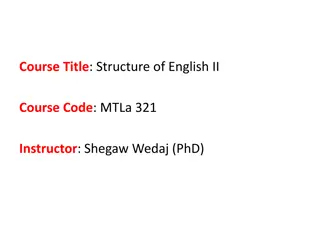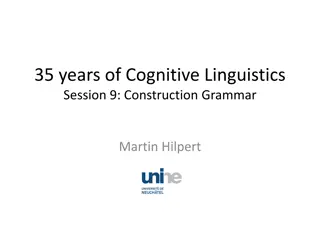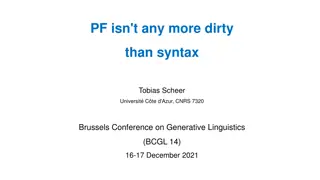Unlocking the Power of Phraseology in Linguistics Research
CPA, led by Patrick Hanks, delves into collocation analysis and meaning interpretation in linguistics. By examining phraseological patterns, the institute aims to build a comprehensive inventory for various verb senses, highlighting the significance of normative and exploitative linguistic uses. The study of corpus linguistics plays a key role in understanding everyday speech patterns and creative language expressions. The research also explores the practical applications in computational linguistics, machine translation, language teaching, and the interplay between logical and analogical aspects of natural language.
Uploaded on Oct 07, 2024 | 7 Views
Download Presentation

Please find below an Image/Link to download the presentation.
The content on the website is provided AS IS for your information and personal use only. It may not be sold, licensed, or shared on other websites without obtaining consent from the author.If you encounter any issues during the download, it is possible that the publisher has removed the file from their server.
You are allowed to download the files provided on this website for personal or commercial use, subject to the condition that they are used lawfully. All files are the property of their respective owners.
The content on the website is provided AS IS for your information and personal use only. It may not be sold, licensed, or shared on other websites without obtaining consent from the author.
E N D
Presentation Transcript
Why do CPA? Patrick Hanks Research Institute for Information and Language Processing, University of Wolverhampton; Bristol Centre for Linguistics, University of the West of England patrick.w.hanks@gmail.com 1
Meaning; collocation Analysing meaning; understanding meaning A set of unresolved problems in linguistics ONE CONTRIBUTION: analyse phraseology Many meanings depend on the presence of more than word for their realization J.M. Sinclair Dictionaries (and WordNet) are a disappointment for software engineers and language learners They list many meanings But they don t say how words are used 2
Aims To build an inventory of the phraseological patterns associated with (each sense of) each verb ( norms ) To relate unusual and imaginative uses to the normal uses of each word ( explotations ) e.g. build a collection of newly created metaphors and similes 3
A discovery of corpus linguistics 85%-90% of everyday speech and writing is phraseologically normal . The phraseological norms can be described and stored as models for future use. 9%-14% is unusual (creative) in some way. About 1% is uninterpretable. 4
Users (target market 1) Applications in computational linguistics Natural language engineers Machine translation? Idiomatic language generation? Message understanding? Information extraction? Escaping the tyranny of text matching 5
Users (target market 2) Language teaching Natural phraseology Error correction Prioritization and choices 6
Logical and analogical A natural language consists of a puzzling mixture of logical and analogical procedures Neglect of the analogical aspect has led to serious errors E.g. the quest for precise definition in ontologies currently being designed for the Semantic Web In ordinary language people make new meanings by comparing one thing with another and by creating ad-hoc sets Not merely by asserting identity Nor by conforming exactly to conventional phraseology Vagueness is an important principle of natural language Danger of confusing language with mathematical logic 7
We need to re-examine the relationship between language and logic The theory of norms and exploitations (TNE) argues that: Talk of an "underlying logical form" of an utterance is pernicious. What "underlies" linguistic behaviour is a set of behavioural regularities -- phraseological patterns. One of the many things that people do with these patterns is to make logics. They do other things too notably, use language patterns for social interaction. 8
A usage-based, corpus-driven theory of language TNE research indicates that language is indeed a rule-governed system BUT: There are two sets of rules, not just one: 1. Rules for using words normally, correctly , boringly 2. Rules for exploiting normal patterns of word use. Exploitations include not only metaphors and similes, but ellipsis, anomalous arguments, irony, etc. etc. The two rule systems interact. Today s exploitation may become tomorrow s norm. Compare Bowdle and Gentner (2005): the Career of Metaphor . The rules are probabilistic, not deterministic. Hanks, P. (2013): Lexical Analysis: Norms and Exploitations. MIT Press. 9























